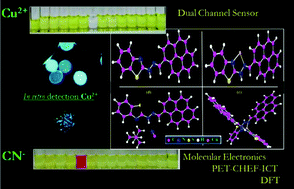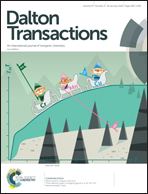Nanomolar-level selective dual channel sensing of Cu2+ and CN− from an aqueous medium by an opto-electronic chemoreceptor†
Abstract
A dual-channel chromogenic and fluorogenic fused-aromatic-system-based chemoreceptor (2-(benzo[d]thiazol-2-yl)-1-((pyren-8-yl)methylene)hydrazine) (TyM) was designed for ditopic sensitivity towards heavy and transition metal ions (HTMs), such as Cu2+, in an aqueous medium and lethal CN− in a semi-aqueous medium. The chemoreceptor displayed proclivity towards the targeted analytes with a distinct optical response (yellow to colourless in the case of Cu2+ and yellow to bright red for CN−). TyM formed a 2 : 1 adduct with Cu2+ with a detection limit of 40 nM. A 1 : 1 binding stoichiometry was confirmed with the chemoreceptor TyM with CN− in sub-nano molar limit of detection. In addition to sophisticated spectroscopic analysis, such as UV-vis, fluorescence, FTIR, 1H-NMR, 13C-NMR, ESI-MS, and HRMS, the plausible mechanistic course of sensing was also established from a theoretical perspective. The reversible UV-vis response of the chemoreceptor TyM towards CN− and H+ can mimic different molecular logic functions and therefore can be exploited for designing several complex electronic circuits principally based on Boolean Algebra. In vitro fluorescence imaging in male microspores of seed plants (Bohonia Nigalandra) and Monilia Albicans (diploid fungus) with TyM and Cu2+ confirmed the permeability of the chemoreceptor TyM at the cellular level as well as its ability to investigate transition metals, such as Cu2+, in biological samples.



 Please wait while we load your content...
Please wait while we load your content...